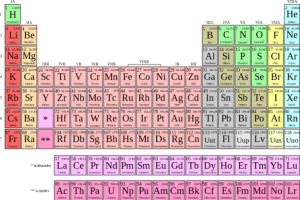Playlist
Show Playlist
Hide Playlist
Periodic Table – Introduction to Chemistry
-
Slides 01 Chemistry Basics Le Gresley.pdf
-
Download Lecture Overview
00:01 Now you’ve probably all heard – I hope you’ve all heard – of the periodic table. 00:05 It lists all of the elements both natural and also man-made in increasing order of atomic number, Z, moving from left to right. 00:17 Here we have the first two groups in the periodic table. I’m showing you here an extract from the first two groups where we have hydrogen (H), lithium (Li), sodium (Na) – remember what I said: sodium actually relates to the Latin natrium, hence the reason why it should be potentially ‘So’ in English but the reality is it comes back to its Latin roots – beryllium, which is the fourth, and magnesium, which is in the third period. 00:54 Now, as you can see in the periodic table, you can observe we’ve got a number of different numbers above and beneath the chemical symbols. If we look at the number above, it is the smallest number and therefore it is the Z number or atomic number. This correlates to the number of protons and the number of electrons that that element possesses in its atomic form. And, as you’ll see, you’ll understand why I say ‘atomic form’ because a lot of elements in nature don’t exist as atoms. 01:28 They actually exist either as ions or they exist as molecules. But for the purposes of explaining basic atomic structure, we consider them in isolation, whether they exist like this in nature or not. As you can see on the board, I’ve introduced another letter there, A, which correlates to the atomic mass, okay? Now notice the atomic mass here is larger than the atomic number and it correlates to the number of protons and the number of neutrons, as I’ve said earlier. 02:05 Also take note of the fact that the numbers are not whole. This is because, in the periodic table, you have to take into consideration the different types of isotopes, which have different masses overall, when calculating the relative atomic mass. And I’ll show you how to do that in a second. Right. So here we have an example of how you would calculate the relative atomic mass of chlorine. And here, as you can see, they are proportional to their abundance. Now recall what I said: 75% of all chlorine atoms exist in their 35 atomic-mass form whereas approximately 25% exist as the 37 atomic-mass form of chlorine. 02:53 So what we need to do is we need to find a weighted average of those two isotopes to give us the relative atomic mass that you would see in the periodic table. 03:01 Now I’m not going to go through this entire equation with you. Suffice to say, conceptually, it’s relatively easy to do. Let’s say, for the sake of argument, you had 75 atoms in one hand each weighing 35 grams and you had 25 in the other hand each weighing 37. All you’d have to do is multiply the mass by each percentage and then average the two. That’s effectively what we’ve done here. 03:33 This gives us an average atomic mass unit for chlorine of 35,5 shown here as 35,45 but, on most periodic tables, you will see it’s rounded up. And whilst the structure of the nucleus is important in radiochemistry and physics, in terms of the chemical characteristics an atom of 35Cl will behave the same chemically as an atom of 37Cl. It makes no difference to their reactivity. The only way you can even detect this sometimes is via certain analytical chemistry techniques which are beyond the scope of this course.
About the Lecture
The lecture Periodic Table – Introduction to Chemistry by Adam Le Gresley, PhD is from the course Chemistry: Introduction.
Included Quiz Questions
Which of the following statements is INCORRECT regarding the proton number?
- Atomic number varies from the number of electrons in an uncharged atom.
- Proton number represents the number of protons present in the nucleus of an atom.
- Atomic number is a unique identifier of an element.
- Proton or atomic number (Z) is always smaller than the mass number (A) of an element.
- Proton number = Charge number of a nucleus
Atomic mass number is always larger than the atomic number for an atom. Why?
- Because atomic number represents the number of protons, whereas atomic mass number represents the total number of both protons and neutrons in the nucleus of an atom.
- Because atomic number represents the number of electrons, whereas atomic mass number represents the total number of both protons and electrons in an atom.
- Because atomic number represents the number of protons, whereas atomic mass number represents the total number of both protons and electrons in an atom.
- Because atomic number represents the number of electrons, whereas atomic mass number represents the total number of leptons, quarks, and bosons (scalar and gauge) in the nucleus of an atom.
- Because atomic number represents the number of neutrons, whereas atomic mass number represents the total number of both electrons and neutrons in the nucleus of an atom.
Customer reviews
5,0 of 5 stars
| 5 Stars |
|
3 |
| 4 Stars |
|
0 |
| 3 Stars |
|
0 |
| 2 Stars |
|
0 |
| 1 Star |
|
0 |
i understood the whole concept from adam sir clearly and wanna learn more from him....
Very educational, a good source for priming for MCAT. Quizzes at the end of slides, and option to take notes while learning are a plus!
perfectly explained and i wanted to ask that i am in class 11 so can i have lectures on that




